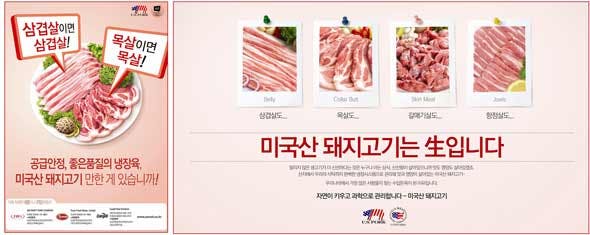U.S. Pork Media Campaign Aims to Build Consumer Trust, Loyalty in Korea
Published: Aug 17, 2011
As the imported pork market share leader, U.S. pork has long been a fixture in South Korea. But consumer awareness has been relatively low because chilled U.S. pork has been a seasonal product in Korea’s retail stores. With the exception of two discount store chains that sold it year-round, chilled U.S. pork has generally been available in the meat case only during the high season (May-August).

Once mandatory country-of-origin labeling was implemented for Korea’s HRI (hotel, restaurant, institutional) sector, Korean consumers began to recognize that pork was imported from many countries. But a big change has occurred over the past year as a result of the severe foot-and-mouth disease (FMD) outbreak in Korea. FMD resulted in a major culling of the domestic hog herd and a shortage of domestic pork, creating hardship for both the HRI and retail sectors. Restaurants are serving a wider range of imported pork cuts, and retail chains have greatly expanded their imported pork selections as well.
To fully capitalize on this opportunity, USMEF-Korea has developed new multi-phase pork trade imaging campaign targeting foodservice end users and pork distributors. Advertisements emphasizing the superior quality and consistent supply of U.S. chilled pork and have been published in leading trade magazines such as Food & People, Monthly Restaurant, Restaurant Management, Hotel & Restaurant, Monthly Franchise, Meat Journal and Meat Magazine.
USMEF-Korea has also placed large advertisements on five of Seoul’s subway platforms this summer, emphasizing the availability of various U.S. chilled pork cuts. The subway is the key mode of transportation in Seoul, with more than 8 million trips taken on it daily.
New radio ads also draw Korean commuters to U.S. pork with the voice of celebrity chef and cooking instructor Shin-gun. The first celebrity endorsement of its kind for U.S. pork, the ads capitalize on Shin-gun’s remarkable popularity with Korean homemakers. USMEF-Korea is also promoting this radio campaign on its Pork Story consumer website.
As a final piece of the campaign, USMEF-Korea is offering truck wrapping for meat distribution companies. The wrap design emphasizes U.S. grain-fed pork’s No. 1 position among Korea’s suppliers of imported pork, allowing the trucks to serve as low-cost, highly visible moving billboards in this densely populated city of more than 10 million.

“Direct consumer advertising for U.S. pork is somewhat new for us in this market,” said USMEF-Korea Director Jihae Yang. “Processors and distributors are still a very important audience for us when it comes to pork. But the FMD-driven shortage of domestic pork has created a tremendous need in other sectors, and consumer trust and confidence are extremely important. So it not only makes sense to reach out more directly to the consumer, it’s essential to stay ahead of our competition.”
The pork imaging campaign is made possible through support from the Pork Checkoff and the USDA Market Access Program (MAP). Through the first half of 2011, U.S. pork and pork variety meat exports to Korea are 145 percent ahead of last year’s pace in terms of volume (122,880 metric tons or 271 million pounds) and have nearly tripled in value to $301.5 million.
